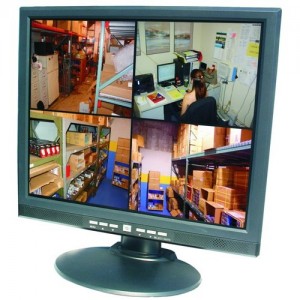 Most digital video security systems today are designed for use with an LCD video camera monitor. There are a few reasons for this, but there are also reasons why it may be difficult to use an LCD monitor. In the following article will discuss LCD monitors how they differ from CRT (Cathode Ray Tube) monitors and some of the advantages of using them instead of a CRT.
Most digital video security systems today are designed for use with an LCD video camera monitor. There are a few reasons for this, but there are also reasons why it may be difficult to use an LCD monitor. In the following article will discuss LCD monitors how they differ from CRT (Cathode Ray Tube) monitors and some of the advantages of using them instead of a CRT.
First of all, to understand the difference that exists between the two types of monitors let’s briefly discuss how each one works. The CRT monitor receives an analog radio frequency signal that contains the information for drawing a picture on the front of the CRT or screen. The CRT shoots horizontal beams of light back and forth from behind the screen very rapidly. If your camera is a 500 TVL (TeleVision Line) camera and your CRT monitor screen is made up of 500 horizontal lines or more, then you’ll see every bit of the video image that is sent to the CRT in good detail.
In other words, the analog resolution measurement as it pertains to non-digital hardware is the TVL. The higher the number the TVL the higher the resolution of the picture display. A 500 TVL display means there are 500 horizontal lines (created by the ray of beams from the CRT). This obviously will show less detail than say a 380 TVL of the same image.
Remember too that these lines can vary in size from monitor to monitor. A 19 inch monitor will have much finer (thinner) lines than a 32 inch monitor.
Also, most analog screens have only two types of possible input/output connectors; a 75 ohm cable connector or an RCA plug. These are a “standard” for analog video connections and are on the backs of most monitors and televisions.
A digital video security camera system Liquid Crystal Display or LCD video camera monitor differs from the CRT type in many ways. First an LCD monitor is designed for digital input not analog. This means there are different standards of measurement for the LCD monitor as compared to the CRT.
Another major difference is in the way the LCD video camera monitor displays its images. Unlike the CRT whose picture consists of horizontal lines, the LCD monitor displays are in pixels. Pixels are very small dots usually round or square in shape that make up the image and entire LCD screen viewing area. Like the CRT’s horizontal lines being an indication of resolution or detail, the LCD’s standard for measurement is the pixel. Keep in mind that pixels vary in size especially from small monitors to large monitors.
However, because these pixels on the average are much smaller than the TVL the LCD video camera monitor automatically makes for a good competitor to the CRT because of the enhanced capability to display a greater resolution or in other words, higher detail.
So the pixel is really the standard of measurement with an LCD video camera monitor. This can be confusing as well because both resolution and size on an LCD video camera monitor are based on pixel measurements. For example your monitor may have a screen that is 800 x 600 pixels. Let’s re-emphasize that the 800 x 600 is the total amount of pixels available for displaying an image.
The image could be 340 x 280 pixels, so what does that tell us? Basically it tells us the SIZE of the image–on your monitor or anyone else’s, the image will be 340 x 280 pixels. (Remember that earlier we said pixel size can change with total screen size.) The actual resolution or detail hasn’t been stated yet but generally speaking, the greatest resolution that can be obtained on an LCD Video Camera Monitor is 96 dpi or dots per inch.
So 96 dpi is actually the resolution. Any image viewed on the monitor with a resolution greater than 96 would be wasting information.
To summarize then, a CRT monitor’s resolution is displayed as TVL or horizontal lines; the more the TVL the more detailed the picture. High definition monitors and TV’s display 1080 TVL. An LCD video camera monitor’s resolution is usually around 96 dots per inch. The pixel measurement, such as 800 x 600 tells how big the image is but not what the resolution is.
So when shopping for an LCD video camera monitor be sure to keep these things in mind to make sure you get the type/size you need.
